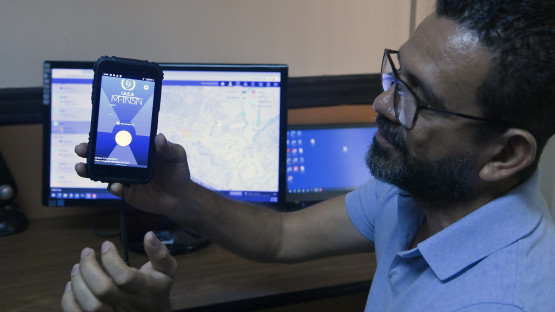

×
If you would like to learn more about the IAEA’s work, sign up for our weekly updates containing our most important news, multimedia and more.
08 Jun 2023 Andrea Rahandini , IAEA Department of Nuclear Safety and Security Vasiliki Tafili , IAEA Department of Nuclear Safety and Security
Enhancing nuclear security detection capabilities with real-time monitoring and mapping of ongoing detection operations is now possible through M-INSN. (Photo: D. Calma/IAEA)
The IAEA has launched a new software tool — the Mobile-Integrated Nuclear Security Network— that provides real time radiation data on operations at high-traffic areas for goods and passengers, such as seaports, land border crossings and airports, which require nuclear security measures to be in place.
The Mobile-Integrated Nuclear Security Network (M-INSN) tool enables decision-makers, to use visual real-time radiation data, to make informed decisions to protect the public in case of a potential incident involving nuclear or other radioactive material.
“The M-INSN is an excellent example of how science and technology can support countries to effectively, efficiently, and sustainably implement relevant nuclear security measures,” said Elena Buglova, Director of the IAEA Division of Nuclear Security. “It can facilitate countries, especially those which lack sustainable means, to exercise command and control over nuclear security operations.”
The key characteristics of this secure communication system are that M-INSN administrators have direct access to real-time radiation data with the exact location of the individual users such as security personnel and radiation experts who use detection equipment, and the system is vendor neutral so any equipment can be incorporated into the user country-controlled software. Equipment status is constantly monitored on command centre computers and is displayed on an interactive map. The collection and aggregation of radiation data in M-INSN provides invaluable information to those involved in overseeing most nuclear security operations.
The M-INSN tool is freely available to countries and its core software is compatible with Windows and Linux computers, using either cloud or non-cloud based-servers. To support the transmission of detector data to the M-INSN server, Front-Line Officers are equipped with smartphones that are linked by Bluetooth to their radiation detectors. A M-INSN App installed on the smartphone securely transmits the data to the user country’s server.
“M-INSN is a secure and vendor-neutral tool, which means that it is designed to work with any electronic equipment used in nuclear security operations, regardless of the manufacturer. Its features, from alarm indicators to language settings, will be completely customizable by users to meet their specific needs. Most importantly, all access and configurations of M-INSN are completely controlled by the user country,” said Charles Massey, Senior Nuclear Security Officer at the IAEA Division of Nuclear Security.
Additional features will be added to the M-INSN in the coming months. Enhancements to M-INSN include “heat mapping” functionality that will automatically monitor previously established radiation level backgrounds and alert the security officers involved about any increased levels of radiation that require further investigation. In terms of equipment range, these include incorporating backpack-based radiation detectors, radioisotope identification devices and handheld X-ray backscatter scanners, and expanding the number of personal radiation detector manufacturers currently supported.
The availability of M-INSN with the IAEA’s other tools, such as the Tool for Radiation Alarm and Commodity Evaluation (TRACE) and the Personnel Alarm Assessment Tool (PAAT), will be a part of the overall toolkit provided to countries to improve radiation detection operations in a variety of scenarios.
M-INSN’s development is supported by funding from Germany and by in-kind contribution from the United States of America.

Egypt’s authorities involved in the implementation of the nuclear security measures during COP27 have been trained by the IAEA on the use of M-INSN and other aspects of nuclear security operations, including response to nuclear security events. (Photo: K. Jenkins /IAEA)
The use of M-INSN goes beyond the support of routine radiation detection operations related to a country’s borders. M-INSN can vastly strengthen the implementation of nuclear security measures during major public events, such as popular international sporting events, to counter potential threats involving nuclear or other radioactive material. The need for early detection of threats from nuclear and other radioactive material is a crucial part of the overall preparations and event security planning activities.
The first-ever use of the M-INSN in a major public event was at the Women’s U-20 Football World Cup, held in Costa Rica in August 2022. It was also used in support of the nuclear security measures in Egypt for the November 2022 United Nations Climate Change Conference (COP 27).
As part of the IAEA’s assistance provided to countries organizing major public events, extensive training on the detection equipment and M-INSN software operation is provided to Front-Line Officers, command centre staff and other entities involved in national nuclear security arrangements.
The IAEA’s nuclear security programme involves developing scientific, technological, and engineering innovations to address current and emerging challenges and risks to nuclear security.
For more information, contact the IAEA at MINSN@iaea.org.